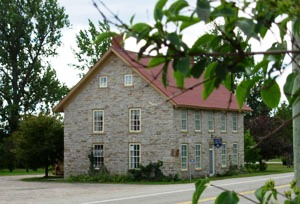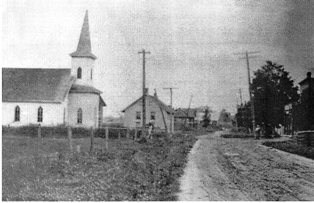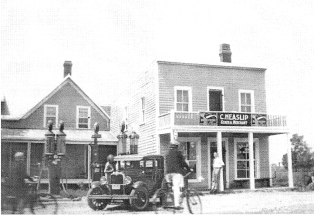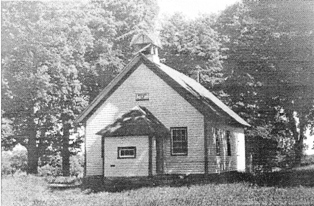Springfield House
Tucked away in the village of Escott stands Springfield House, an impressive stone building whose origin was somewhat of a mystery. Its recent history is more familiar to the local population who knew it as the Escott Library and Heritage Centre. However, when it was purchased by the Township of Escott in 1978 it was uninhabited and in a derelict state.
There has never been any doubt that Springfield House is a gem of a heritage structure, but the public knowledge of the building's history has been skimpy. In a letter to the editor of the Brockville Recorder dated September 14, 1871, mention is made of a new hotel and a proposed township hall for Escott. "A Town and Masons Hall are to be erected here immediately... There is also a large hotel to be built. The walls are commenced. The building will be of stone." The letter was signed, Traveller. What is today known as the village of Escott, was in the 1870's, more specifically called Springfield.
The construction of Springfield House was closely connected with that of Front of Escott's Township Hall in more ways than one. Indeed, the man who owned the land where both buildings would appear was Reuben Fields. Fields was a local sawmill owner, carpenter, builder and the sometime Reeve of Escott - as well as being a prominent Mason. When the Township Council under Reeve Fields decided it was time for a proper hall, and simultaneously the local Masonic Lodge felt a great need for a regular meeting place, Fields sold them his land for $50. The downstairs of this building was to house the township hall and the second storey was constructed by and for the Masons of Macoy Lodge #242. The lower portion of the hall cost $700, and the upper $686.
On learning of the proposed hall for Escott, a young farmer from Quabbin, John Gerald Kavanaugh, saw the potential for a new hotel in the village right on the King's highway. His mind had been turning to the thought of making an investment, since the death of his father, Garret in May of 1871 had left him a small inheritance. J.G. anticipated new business would be passing through the Village of Escott. He also envisioned councillors possibly having to spend the night at Escott after long and stormy sessions. The Masons, too, would be coming from some distance for their regular meetings and would require food and lodging, and perhaps a little nip to warm them on a cold winter's night or refresh them on a hot summer's eve.
Kavanaugh, a young man in his early thirties at the time he built Springfield House, had been born in MacIntosh Mills as had Reuben Fields. Whether this was a coincidence he played up in his dealings with Fields is not known. At any rate, he apparently worked out an agreement to lease and then purchase the land adjacent to the proposed new hall and put the building up at his own expense. It is not known where Kavanaugh got the inspiration for the design of his building. It was not at all typical of the Victorian buildings of the 1870's, but was more suggestive of the Georgian style which flourished in the 18th century particularly in the United states. The use of stone in the construction was unusual, in that it is believed that the stone was not local stone, but was brought from Kingston. It is also thought that the stonemason was James Kavanaugh, J.G.'s brother.
By December of 1871 Springfield House was up and operating as a hotel. The actual papers deeding the land to Kavanaugh for $40 were not drawn up until April of 1873, by which time the hotel had been in operation for more than a year. Sometimes business deals were not put on record, and Mr. Kavanaugh and Mr. Fields may not have bothered to register the land transfer until the time came when a mortgage was needed. Or perhaps the original intention was to simply lease the land and purchase at a later date. At the same time, Kavanaugh arranged a mortgage on the hotel for $210. This suggests that the business may not have lived up to his expectations or that he had overextended his enterprise.
J.G. Kavanaugh was not destined to continue in the hotel business for long. In May 1875 he sold the place to Henry Andress for $950. Within a few years he moved to Manitoba with his family. Springfield House remained in the Andress family for nearly 100 years. Henry Andress and his wife Lucy, with their 14 children made good use of the big house.
Hannah Andress was the 9th child in the family, and the one girl who never married. Her father died in 1902, her mother in 1910, and Hannah continued to live in the big house after their deaths. In a letter, Hannah refers to her home as the "Stonepile", and indeed put the name at the top of the letter as her address.
At some time Hannah found the house too large for her alone, and she made a decision to rent out half of it to tenants. In 1924, Ernest Carl Kelly and his wife Fanny lived for one year at Springfield house. He was secretary of the Springfield Cheese factory and simultaneously served as the township clerk for a number of years. At the time they lived in the house, there was a grocery store in one comer of the building.
Whatever secrets and stories might have been in the attic of the "Stonepile" were destroyed. All the old papers were burned by the last tenant who lived there while the house was still owned by Hannah Andress. When she died in 1951, she left the place to her niece Myrtle, who was Mrs. Charles Miller. Myrtle lived there until 1971. Although the exact date of purchase is not known (it was not registered until 1977). Myrtle appears to have sold the place around 1951 to Pearl Fenlong. Land registry records show the old hotel was purchased by her for $800 (less than it had sold for 100 years before). This is another indication that the building had fallen into a state of neglect.
Ron Fenlong, the son of Pearl and George Fenlong, was born at Springfield House in 1952. The eight Fenlong children and their parents lived in the big old house for a number of years, later renting it out. At the time the Fenlongs lived there, the house was no longer divided in two nor was there a store in the building.
When Springfield House was purchased by the township in 1978, it had been vacant for some time. After an extensive restoration, completed in 1982, it housed the library, meeting rooms, archives and a museum.*
For more information on Springfield, see our Fall/Winter 2003 Newsletter.
* This article was published in our Fall/Winter 2003 Newsletter. The material was taken from The History of Springfield House by Mary Joan Barrett, Copyright 1993 and is used with permission.
Summer 2024 - Closed for necessary upgrades that are expected to begin soon. The building is currently not open to the public. After the branch library was closed (approximately 2014) the building was used by LTI Archives. A community group "Friends of Springfield House" (Facebook) is developing plans for the future.
Top of Page
|





